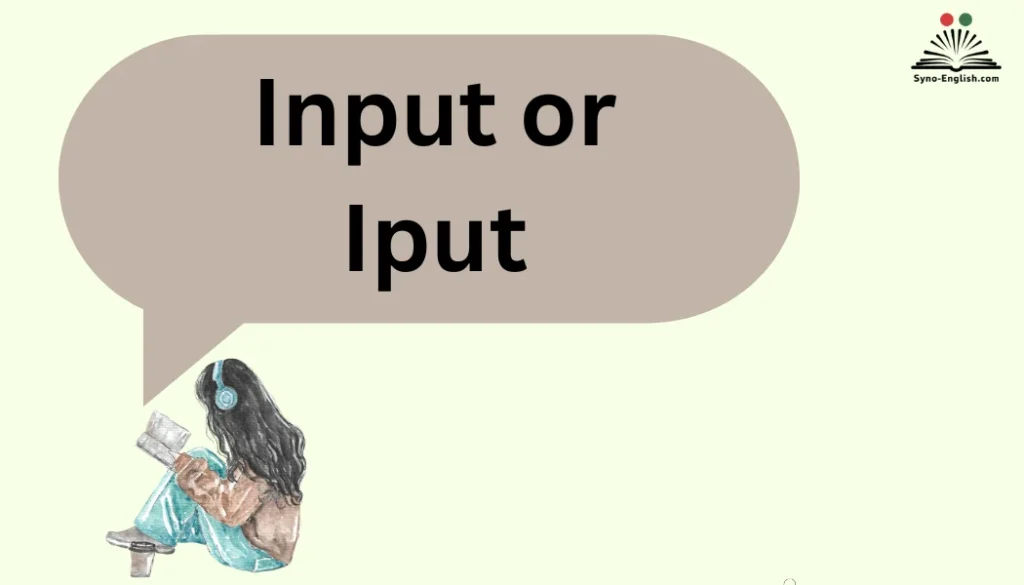The article unpacks the confusion surrounding how we use language, particularly in the case of Input or Iput: a phrase that often sparks curiosity among learners. This discussion explores the meaning, history, and proper usage of the word across different fields like computer science, communication, and education.
The word shows how data or information moves from one source to another, and understanding that process helps learners use it correctly and avoid future mistakes.Many learners realize that clarity in spelling often reflects clarity in thought, forming the base for strong writing habits.
I’ve noticed that when people grasp the essence of “input,” they also start recognizing how careful writing strengthens communication skills. Developing a habit of checking your words isn’t just about accuracy—it’s about consistency, and that’s what turns ordinary writing into meaningful expression.
Understanding the Confusion Between “Input” and “Imput”
Language errors don’t happen in a vacuum. People often type imput instead of input for a few reasons:
- Pronunciation habits: In rapid speech, “input” can sound like “imput.” For non-native speakers, this makes the error more likely.
- Typing slips: On a keyboard, the letters m and n sit close together. That one-letter slip can create a typo.
- Regional influences: Certain accents and dialects blur vowel and consonant sounds, leading to misspellings.
- Online informality: In casual settings like chat rooms or social media, users type phonetically and skip spell-check.
Still, it’s worth stressing: imput doesn’t exist in English dictionaries. It’s a spelling mistake, not a variant.
Quote: “Correct spelling is the backbone of clarity. A single misplaced letter can derail meaning.” — Language Research Journal
The Correct Word: “Input”
At its core, “input” means information or resources put into a system. It serves as both a noun and a verb.
- As a noun: Input refers to something contributed, whether ideas, energy, or data.
- As a verb: To input means to provide or enter information.
Definition from Cambridge Dictionary: “Input is advice, opinions, or information that helps someone make a decision or enter into a discussion.”
Etymology of “Input”
- First appeared in English around the mid-20th century.
- Derived from the simple combination of in + put, meaning “to put in.”
- Became widely used with the rise of computing and data science in the 1950s.
This makes it a relatively modern English word compared to older verbs like write or speak.
The Wrong Word: “Imput”
“Imput” is not a real English word. You won’t find it in Oxford, Merriam-Webster, or Cambridge.
However, the confusion grows because of “impute,” a real but unrelated word.
- Impute (verb): To assign blame, credit, or cause.
- Example: “They impute the accident to driver error.”
- Imput: A common typo for input; nothing more.
This mix-up means many people mistakenly write imput when they mean input. Others confuse imput with impute.
How to Use “Input” Correctly
Input as a Noun
Meaning: Something contributed—whether data, ideas, or material.
Examples:
- “The manager asked for input before launching the new product.”
- “Energy input is required for any chemical reaction.”
- “Without student input, the curriculum changes would have failed.”
Key takeaway: As a noun, input is about what goes in—whether information, effort, or resources.
Input as a Verb
Meaning: To provide or enter information into a system.
Examples:
- “You need to input your password before logging in.”
- “She input the survey results into the database.”
- “Data is manually input by researchers for accuracy.”
Note: In modern usage, the past tense can be either “input” or “inputted.” Both are acceptable, though input is more common in professional writing.
Input Across Different Fields
Technology
- Refers to data provided by a user, device, or program.
- Examples:
- Keyboard input (typing).
- Voice input (speech recognition).
- Sensor input (IoT devices).
Business and Collaboration
- Input means advice, feedback, or contributions from team members.
- Examples:
- “We need input from the finance team before finalizing the budget.”
- “Her input shaped the company’s new marketing strategy.”
Everyday Language
- Used in casual speech when asking for opinions.
- Example: “I’d like your input on where we should go for dinner.”
Common Mistakes and How to Avoid Them
- Typing “imput” instead of “input.”
- Fix: Remember that input contains “in” not “im.”
- Mnemonic: “You put info IN = input.”
- Confusing input with impute.
- Input: To contribute or enter data.
- Impute: To assign blame or responsibility.
- Using input incorrectly in plural form.
- Correct: “Inputs” (multiple sources of data).
- Wrong: “Inputes” or “imputs.”
Why Accuracy Matters
Spelling may seem like a small detail, but it carries weight in professional and digital settings.
- Professional credibility: Misspelling words like input in emails, reports, or applications can appear careless.
- Clarity: Readers may stumble or misunderstand your message.
- SEO and online writing: Search engines recognize input but not imput. Using the wrong spelling means your content may not be found.
Case study: A software company once found its online help documents contained dozens of instances of imput. Customers flagged it, and the company corrected them. The fix improved readability scores and boosted search visibility for technical articles.
Quick Reference Guide
Here’s a table to quickly distinguish between input, imput, and impute.
| Word | Correct? | Meaning | Example |
| Input | ✅ Yes | Information entered or contributed | “Your input was helpful.” |
| Imput | ❌ No | Not a real word | – |
| Impute | ✅ Yes | Attribute/assign | “They impute success to hard work.” |
Extra Tips for Remembering “Input”
- Think of input as the opposite of output.
- Visualize typing information into a box—it goes “in.”
- Use flashcards or autocorrect tools to reinforce the correct spelling.
- Remember: Spell-check will always flag imput but not input
Conclusion
The difference between Input or Iput goes beyond spelling—it’s about attention to detail and understanding the role of precision in language. When we type input, we’re referring to information or data being entered, processed, or shared, whether in technology, education, or daily conversation. Choosing the correct form not only avoids confusion but also reflects professionalism. Every time we pause to check our words, we reinforce habits that make our writing clear, structured, and confident. This mindful approach helps learners and professionals alike build credibility and accuracy in their work.
Moreover, using input correctly is a small but powerful act that strengthens communication. It reminds us that clarity is not achieved through complexity but through care and correctness. A single misplaced letter like “imput” might seem minor, yet it can subtly shift how others perceive your attention to detail. Understanding the meaning, usage, and history of “input” transforms it from a basic term into a symbol of precision. Ultimately, mastering this small distinction prepares you to communicate with authority, ensuring that your message is always understood exactly as you intended.
FAQs
What is the correct spelling—Input or Iput?
The correct spelling is Input. “Iput” is a common typing mistake that doesn’t exist as an English word.
What does “Input” mean?
“Input” means data, information, or ideas entered into a system, device, or conversation for processing or response.
Why is “Iput” wrong?
“Iput” is simply a typo or misspelling. It has no meaning or recognized usage in English.
How can I remember the correct spelling?
Think of “in” plus “put” — meaning to put something in. This helps you remember the correct form.
What are examples of input?
Examples include typing text into a computer, giving feedback in a meeting, or entering data into a system.
Why is correct spelling important?
Correct spelling shows attention to detail, builds credibility, and ensures your message is easily understood.
Where is the term “input” commonly used?
It’s used in computing, education, communication, and business to describe the act of providing information.
How does wrong spelling affect writing?
Spelling mistakes can confuse readers and make writing look careless or unprofessional.
What’s the history of the word “input”?
“Input” originated from the combination of “in” and “put,” first used in the mid-19th century for data entry.
How can I avoid typing errors like “Iput”?
Type slowly when writing important text, use spell check, and review your work before sending or submitting it.

Emma Brooke is a passionate English educator, writer, and language enthusiast with over a decade of experience helping learners master the nuances of the English language. At SynoEnglish, she blends practical grammar advice with real-world communication tips to make English easier, clearer, and more enjoyable for readers of all levels.



